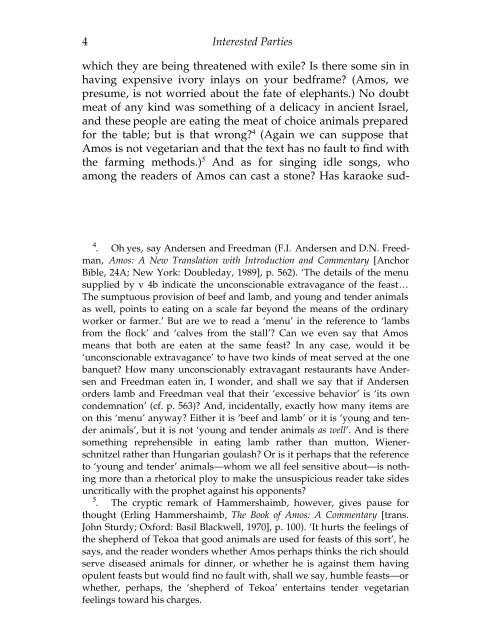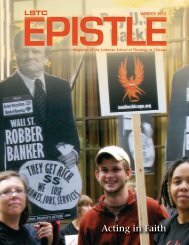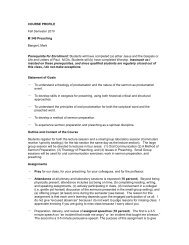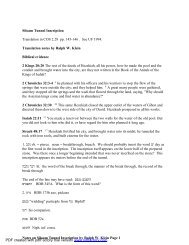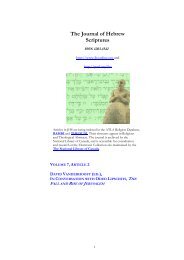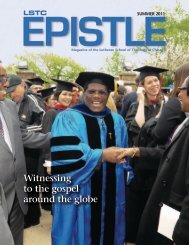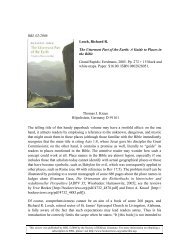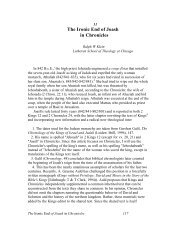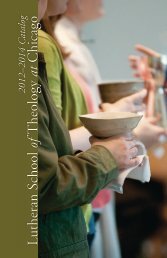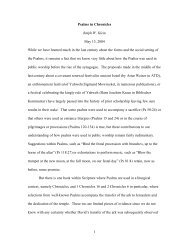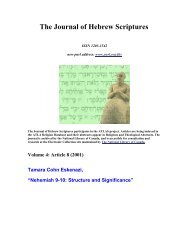Metacommentating Amos* Metacommentary, what is that ... - Fontes
Metacommentating Amos* Metacommentary, what is that ... - Fontes
Metacommentating Amos* Metacommentary, what is that ... - Fontes
Create successful ePaper yourself
Turn your PDF publications into a flip-book with our unique Google optimized e-Paper software.
4 Interested Partieswhich they are being threatened with exile? Is there some sin inhaving expensive ivory inlays on your bedframe? (Amos, wepresume, <strong>is</strong> not worried about the fate of elephants.) No doubtmeat of any kind was something of a delicacy in ancient Israel,and these people are eating the meat of choice animals preparedfor the table; but <strong>is</strong> <strong>that</strong> wrong? 4 (Again we can suppose <strong>that</strong>Amos <strong>is</strong> not vegetarian and <strong>that</strong> the text has no fault to find withthe farming methods.) 5 And as for singing idle songs, whoamong the readers of Amos can cast a stone? Has karaoke sud-4 . Oh yes, say Andersen and Freedman (F.I. Andersen and D.N. Freedman,Amos: A New Translation with Introduction and Commentary [AnchorBible, 24A; New York: Doubleday, 1989], p. 562). ‘The details of the menusupplied by v 4b indicate the unconscionable extravagance of the feast . . .The sumptuous prov<strong>is</strong>ion of beef and lamb, and young and tender animalsas well, points to eating on a scale far beyond the means of the ordinaryworker or farmer.’ But are we to read a ‘menu’ in the reference to ‘lambsfrom the flock’ and ‘calves from the stall’? Can we even say <strong>that</strong> Amosmeans <strong>that</strong> both are eaten at the same feast? In any case, would it be‘unconscionable extravagance’ to have two kinds of meat served at the onebanquet? How many unconscionably extravagant restaurants have Andersenand Freedman eaten in, I wonder, and shall we say <strong>that</strong> if Andersenorders lamb and Freedman veal <strong>that</strong> their ‘excessive behavior’ <strong>is</strong> ‘its owncondemnation’ (cf. p. 563)? And, incidentally, exactly how many items areon th<strong>is</strong> ‘menu’ anyway? Either it <strong>is</strong> ‘beef and lamb’ or it <strong>is</strong> ‘young and tenderanimals’, but it <strong>is</strong> not ‘young and tender animals as well’. And <strong>is</strong> theresomething reprehensible in eating lamb rather than mutton, Wienerschnitzelrather than Hungarian goulash? Or <strong>is</strong> it perhaps <strong>that</strong> the referenceto ‘young and tender’ animals—whom we all feel sensitive about—<strong>is</strong> nothingmore than a rhetorical ploy to make the unsuspicious reader take sidesuncritically with the prophet against h<strong>is</strong> opponents?5 . The cryptic remark of Hammershaimb, however, gives pause forthought (Erling Hammershaimb, The Book of Amos: A Commentary [trans.John Sturdy; Oxford: Basil Blackwell, 1970], p. 100). ‘It hurts the feelings ofthe shepherd of Tekoa <strong>that</strong> good animals are used for feasts of th<strong>is</strong> sort’, hesays, and the reader wonders whether Amos perhaps thinks the rich shouldserve d<strong>is</strong>eased animals for dinner, or whether he <strong>is</strong> against them havingopulent feasts but would find no fault with, shall we say, humble feasts—orwhether, perhaps, the ‘shepherd of Tekoa’ entertains tender vegetarianfeelings toward h<strong>is</strong> charges.


